- Prelude
- Editorial
- Raghu Rai: The Historian
- Ryan Lobo, 34 in Baghdad
- Through the Eye of a Lensman
- Adrian Fisk
- And Quiet Flows the River
- The Lady in the Rough Crowd: Archiving India with Homai Vyarawalla
- Raja Deen Dayal:: Glimpses into his Life and Work
- Raja Deen Dayal (1844-1905) Background
- Vintage Views of India by Bourne & Shepherd
- The Outsiders
- Kenduli Baul Mela, 2008
- Collecting Photography in an International Context
- Critical Perspectives on Photograph(y)
- The Alkazi Collection of Photography: Archiving and Exhibiting Visual Histories
- Looking Back at Tasveer's Fifth Season
- Kodachrome: A Photography Icon
- Three Dreams or Three Nations? 150 Years of Photography in India, Pakistan and Bangladesh
- Show And Tell – Exploring Contemporary Photographic Practice through PIX
- Vintage Cameras
- Photo Synthesis
- The Right Way to Invest
- What Happened and What's Forthcoming
- Art Events Kolkata: March – April 2011
- Art Bengaluru
- Mumbai Art Sighting
- North East Opsis
- Previews
- In the News
- Somnath Hore
ART news & views
Raghu Rai: The Historian
Volume: 3 Issue No: 16 Month: 5 Year: 2011
Creative Impulse
A Conversation between Uma Prakash and Raghu Rai

A narrow winding road passing magnificent ruins and an expanse of untamed greenery finally ended at legendry photographer, Raghu Rai's studio. While his bay windows opened to an incredible view of the Qutub Minar, Indian classical music played serenely in the background. Rai's senses embrace nature, beauty and music in unison, enabling him to create a unique visual language through his photographs.
When Raghu Rai captures a moment through his lens,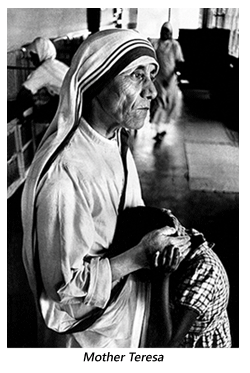 he displays an acute sensitivity, taking the viewer through an inner journey as he searches for a deeper meaning into the lens of his camera. There is a keen sense of embracing humanity through a moment of spiritual revelation in his work.
he displays an acute sensitivity, taking the viewer through an inner journey as he searches for a deeper meaning into the lens of his camera. There is a keen sense of embracing humanity through a moment of spiritual revelation in his work.
Qualified in civil engineering, it was by accident that he became a photographer.
“It happened just by chance. My elder brother, S. Paul was already a photographer. I was staying with him. One of his friends, Yog Jain was going to his village to take some pictures. I told my brother to give me a camera to shoot some pictures. The first picture I took was of a baby donkey. At that time the Times used to print weekend pictures that were sometimes funny or odd. My brother sent my picture to them. They published it with my byline. That gave me enough to carry on for a month. So I decided it was not a bad idea to become a photographer.”
Photography is sometimes considered an art form today. However Rai feels that photography plays an even more significant role in our lives.
“The purpose for photography for me is specific and cannot be replaced by any other form of expression like painting and writing. It has a very specific role to play. Photography started 150 years ago. Some of the first photographers started working in India under the aegis of the East India Company. On the other hand Bourne and Shepherd was an independent firm that started functioning around 1865. Take a street shot of Chowringhee square and compare it with a Husain or Gujral painting done on the same subject. The first response when viewing the photograph will be 'That's the way it used to be”. It is a photo history of that time. History is written and can be rewritten. Photo history cannot be recreated. Those were the years of large cameras with slow and heavy films. Today you can capture a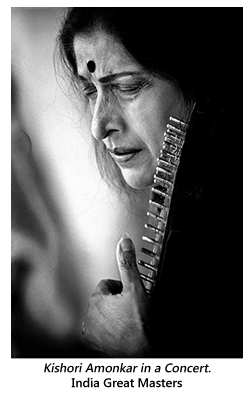 moment in a flash of a second with all the complexities and layers of experience. If you are sensitive and your feelings are meaningful, then your pictures will stay alive.”
moment in a flash of a second with all the complexities and layers of experience. If you are sensitive and your feelings are meaningful, then your pictures will stay alive.”
Dabbling in issues of identity, race and social structure, he has documented all aspects of India, showing its growth and successive changes in a personal manner. His work is deeply expressive, completely mesmerising the viewer, making it a unique visual experience. He unfolds many stories through his visual narrative like the Bhopal Gas tragedy of December, 1984, which was perceived in a humanitarian spirit having been produced for Greenpeace, India. From his numerous books on India, it is obvious that Rai's inspiration is here. Over the last 40 years, he has created numerous books¹ on Calcutta, Delhi, Agra, Khajuraho, Lakshadweep, My Land and Its People, Dreams of India, The Sikhs, Indira Gandhi (with Pupul Jayakar), Mother Theresa, India's Great Masters etc.
It is amazing how Rai had captured the classical musicians in his latest book, India's Great Masters.
“I started photographing the musicians from 1970. I had no plans of doing a book. I enjoy music and taking pictures of the musicians. I was working with India Today and in the 80's we did several pages on big musicians. The idea was to take photographs that would capture the moments that reveal the spirit that is characteristic to them.” Rai concedes that when he became a photographer in the 1960s, it also became a turning point in his spiritual quest for listening to and appreciating music. He attended concerts and even visited the homes of the legends of Hindustani music in order to photograph them. According to Rai, the shots in the book are in black and white because he considered them serious  subjects that needed serious treatment. The meditative nature of the photographs has not been achieved by accident; rather it is the result of contemplating how best to expose their inner sensibilities while at work.
subjects that needed serious treatment. The meditative nature of the photographs has not been achieved by accident; rather it is the result of contemplating how best to expose their inner sensibilities while at work.
Raghu Rai has never stopped shooting the musicians. His obsession for music comes to the fore as he photographs them in concerts, in their homes, with their gurus, and in special locations. In this book, Rai focuses on thirteen masters who have reached great heights with their music. They include Ravi Shankar, Ali Akbar Khan, MS Subbulakshmi, Mallikarjun Mansur, Kumar Gandharva, S. Balchander, Alla Rakha, Zakir Hussain, Vilayat Khan, Bismillah Khan, Kishori Amonkar, Hari Prasad Chaurasia and Bhimsen Joshi. As eight of these masters have already passed away, these sensitive, powerful, joyous portraits are testimony to Indian musical heritage.
Rai has managed to capture Kishori Amonkar in a musical trance; Alla Rakha, and his son Zakir Hussain against a breathtaking view; Bismillah Khan and Bhimsen Joshi were taken at ingenious angles revealing the photographer's aspiration to move beyond the ordinary frontal gaze of the photographer. Rai's understanding of classical music helped him attain that extra dimension and his ability of catching the right mood displays his own artistic experience.
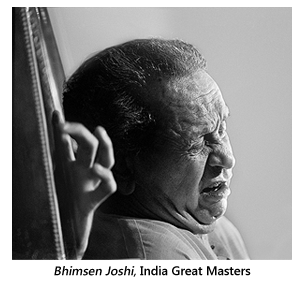
With his wide range of photographs, it would be difficult to pinpoint a particular best shot. However there is a particular shot that Rai considers his best which he revealed in his interview with Andrew Pulver from the Guardian in February 2010.
“When I was doing my second book, about Old Delhi, I was in the habit of visiting the Jama Masjid, one of the oldest mosques in India. I used to meet a politician there called Saeed, a very nice guy. One day he said to me: "You should come with me and you won't believe your eyes.
We walked half a mile up the ridge behind the mosque to his house. Because of its position, you could see the whole city. It was a wonderful sight: you could see the Mosque, the Red Fort, the Old City. It was late summer and people were spending their afternoons on rooftops: young people flying kites, that sort of thing. I started shooting and kept going for two or three hours. But, fascinating though the panorama was, I thought something was missing. I couldn't connect with it in a human way.
Then, as the sun was setting, I walked down a staircase from the roof, and saw this young woman doing 'namaz', praying, in Saeed's cousin's house. I took four or five quick shots. I was lucky: it all came together, the light, the clouds, the landscape and the figure. I've never actually met the woman I photographed, but after the picture won an award, I gave a print and a copy of my book to Saeed. I know the whole family was delighted with how it turned out.”
Raghu Rai was born in 1942 in a small village called Jhang, British India (now in Pakistan). He took up photography in 1965, and joined The Statesman newspaper as its chief photographer the following year. He left The Statesman after 11 years to work as picture editor for Sunday, a weekly news magazine published in Calcutta. Impressed by an exhibit of his work in Paris in 1971,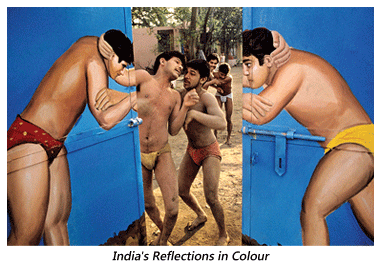 Henri Cartier-Bresson nominated Rai to join Magnum Photos in 1977. Rai eventually left Sunday in 1980 and worked as Picture Editor/Visualizer/Photographer of India Today, India's leading news magazine, during its formative years. From 1982 to 1991, he worked on special issues and designs.
Henri Cartier-Bresson nominated Rai to join Magnum Photos in 1977. Rai eventually left Sunday in 1980 and worked as Picture Editor/Visualizer/Photographer of India Today, India's leading news magazine, during its formative years. From 1982 to 1991, he worked on special issues and designs.
Rai's work with newspapers left him dissatisfied as he soon realized that daily stories died a daily death. He felt an image must stay alive for itself in order to be timeless. Subjects and issues addressed in papers didn't last. He wanted to create images that had a life of their own - from images of the poor laborers, Mother Teresa to birds flying near the horizon. He wanted to share with the world, all the images that excited him. And so, Rai nurtured a creativity that was waiting to explode. His Taj Mahal image exudes an intimate atmosphere as he juxtaposes common folk enjoying the warmth of an open fire on a cold wintry evening with the magnificent edifice caught in the light of a glorious sunset. There is a clear mix of the magical and surreal and at the same time, a narrative both subtle and sensual that enhances the viewer's accessibility.
Another exciting work is a photograph of a desert dust storm in Rajasthan caused by the helicopter of a VIP. Here he has captured a stark reality, allowing the observer to actually feel the resulting sandstorm. His hard-hitting images instantly seize the viewer's attention as Rai draws the viewer into his experience.
His portrait of the late Prime Minister of India, Indira Gandhi in a sari captures her apprehensive expression with downcast eyes, depicting her great responsibility in heading the second biggest democracy in the world. A humble selfless attitude is evident in the Mother Teresa portrait. "A good photograph is that which combines mind, body and spirit. It's a darshan in the most profound sense," said the photographer.
Rai's favorite city is Kolkata, 'the city of joy'. 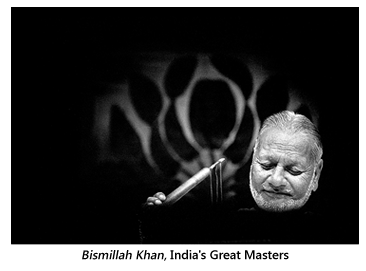 Although he has captured the humane expressions of the ordinary man in the street on numerous occasions, he is drawn to this city because he feels the people of Kolkata emanate a human energy and expression that is unlike any other in India. Through his pictures of a labourer taking a nap, a woman along the Hooghly River, and Goddess Durga's idol being taken a rickshaw among several others, the artist has captured the essence of Kolkota.
Although he has captured the humane expressions of the ordinary man in the street on numerous occasions, he is drawn to this city because he feels the people of Kolkata emanate a human energy and expression that is unlike any other in India. Through his pictures of a labourer taking a nap, a woman along the Hooghly River, and Goddess Durga's idol being taken a rickshaw among several others, the artist has captured the essence of Kolkota.
Furthermore the city has an old world charm that is like magic for him as he confesses that he is not fond of certain kinds of changes. “Most changes are expressionless. There are neat, straight-lined buildings with no distinct character. Look at the old architecture, so meaningful and interesting. So many styles… things happening in each detail. The Dalhousie Square is such a phenomenal place. The other area I love is the Maidan. When I used to shoot Calcutta, during weekends I only used to stay on the Maidan. Eat, drink my chai three-four times, take pictures, sleep there on the grass and go back…” (The Telegraph Calcutta December 2010.)
Rai feels that in the old days, capturing a moment in space was enough but today this is outdated. As India is multilayered, both geographically and culturally, he sometimes needs to use a panoramic camera, thereby capturing a sweeping view of life. His advice to aspiring photographers is to be creative and not just copy others. According to him, two things are important for a good photograph: It should have the freshness of vision and must have the power to stay alive. It should have the intensity and expression of a timeless quality. Get out of your comfort zone and be tough on yourself. All good guys are easy, breezy and boring. That's the mold you have to break.
Footnote:
¹ Calcutta, Time Books International, India, 1989
Delhi and Agra (with Lai Kwok Kin and Nitin Rai), Hunter Publications, Inc., USA, 1990
Dreams of India, Time Books International, Singapore; (L'Inde), Arthaud, France, 1988
Indira Gandhi: A Living Legacy, Timeless Books, India, 2004
Mother Theresa: A Life of Dedication, Harry N. Abrams, USA, 2005
Images Courtesy: Raghu Rai